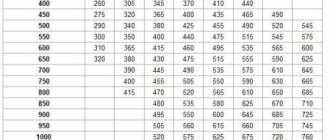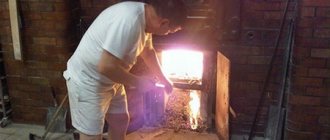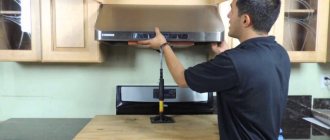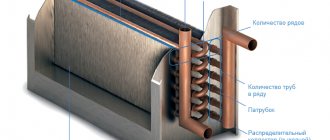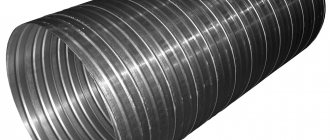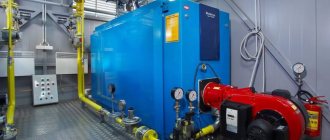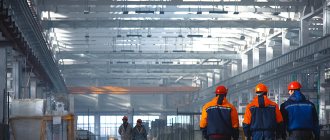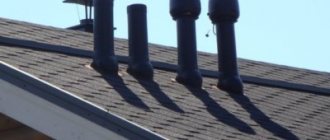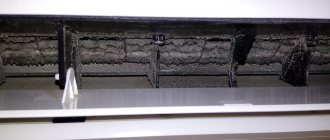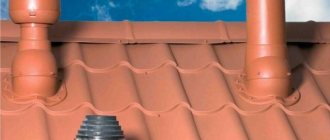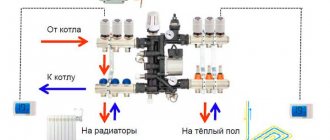Home › Ventilation › Ventilation of residential buildings
You can order ventilation of a residential building with turnkey installation by calling us by phone in Moscow. We design and supply ventilation systems throughout Russia. We ask you to send your written application by email or through the form on the website.
- The influence of indoor ventilation on humans
- Regulatory Requirements
- Residential building ventilation systems
- Design of ventilation in a residential building
- Ventilation calculation
- Installation
- Recommendations from experts
Send an application and receive a CP
The purpose of ventilation is to provide sanitary and hygienic conditions for a person to stay indoors - temperature, relative humidity, air speed (mobility) and air purity, for which ventilation devices must assimilate or remove excess heat, moisture, and gases , vapors, dust while maintaining a certain air mobility in the room. Ventilation systems are designed to ensure air parameters within the work area. The working or service area of a room is a space 2 m high above the floor or platform where there are places for permanent or temporary residence of people.
“Standard Climate” is a professional climate control company, ready to implement turnkey solutions to any problems regarding climate control and other engineering equipment. We will carry out a full cycle of work: selection of equipment, design, installation, delivery and maintenance. You can submit an application on the website airclimat.ru. Call now: +7(499) 350-94-14
. Submit your application
The influence of indoor ventilation on humans
From the point of view of energy saving, modern research has proven that due to ventilation systems in a house or apartment, up to 30 percent of all possible heat losses occur here.
By installing modern plastic windows in the premises of the house, we naturally significantly save heat here, but at the same time, we also significantly reduce ventilation, that is, air exchange here. For a person, such improvement of our homes, as a rule, does not lead to an improvement in the conditions of his work and rest, but rather the opposite.
As modern special studies have shown, a reduced level of ventilation in rooms leads to a significant lack of oxygen here, and, accordingly, to our rapid fatigue when doing any work, our headaches, as well as our poor and uncomfortable rest and sleep here.
It has also been fully proven that insufficient ventilation in the room always leads to increased humidity in the house. In such an unventilated house, as a rule, the windows and walls always “cry”, and especially with the onset of cold weather. Mold and mildew often appear on the ceilings and walls of rooms; their appearance clearly deteriorates and does not bring us any satisfaction.
In addition, fungal spores from the walls, spreading in the air of the house, can cause various, and quite serious, diseases of the respiratory system in humans. We have now turned our homes into a thermos, where we are warm, but not at all comfortable to be, and sometimes even dangerous to our health. Therefore, “proper” ventilation in the house significantly increases the comfort of working and living in it.
Regulatory Requirements
Let's start by studying the current regulatory documents. Current SNiPs for ventilation of residential buildings are 2.04.05-91 “Heating, ventilation and air conditioning” and 2.08.01-89 “Residential buildings”.
For the convenience of the reader, we will bring together the key requirements of the documents.
Temperature
For a living room, it is determined by the temperature of the coldest five-day period of the year.
- If its value is above -31C, it is necessary to maintain at least +18C in the rooms.
- When the temperature of the coldest five-day period is below -31C, the requirements are slightly higher: the rooms must be at least +20C.
For corner rooms that have at least two common walls with the street, the norms are 2 degrees higher - +20 and +22C, respectively.
Useful: the variability of requirements is due to the fact that at low temperatures and increasing heat loss, the dew point (the point in the thickness of the enclosing structure where condensation of water vapor begins) shifts towards the inner surface. The indicated temperatures exclude freezing of the wall.
Consequences of freezing.
For bathrooms, the minimum temperature is +18C, for baths and showers - +24.
Air exchange rates
What are the standards for ventilation of residential premises (more precisely, the rate of air exchange in them)?
| Room | Minimum air exchange |
| Living room | 3 m3/hour per 1 m2 area |
| Kitchen | 60 m3/hour for electric stoves and 90 m3/hour for gas stoves |
| Bathroom, toilet room | 25 m3/hour |
| Combined bathroom | 50 m3/hour |
Additional requirements
What other requirements and recommendations can be found in SNiP for heating and ventilation of residential buildings?
- The ventilation scheme may provide for air exchange between separate rooms. Simply put, you can organize an exhaust hood in the kitchen, and air flow in the bedroom. Actually, the document specifies the recommendation: exhaust ventilation should be provided in kitchens, bathrooms, bathrooms, toilets and drying cabinets.
In Stalinka buildings you can see two ventilation grilles in the kitchen area. One of them opens into a chimney: the houses were built for stove heating.
- The ventilation of the apartment must be connected to a common ventilation duct no lower than 2 meters from the ceiling level. The instructions are intended to minimize the likelihood of the rod overturning in windy weather.
- When using separate rooms in a residential building for public needs, they are equipped with their own ventilation system, not connected to the general one.
- When the temperature of the coldest five-day period is below -40C for three-story and higher buildings, it is allowed to equip fresh ventilation with heating systems.
- Gas boilers and water heaters with combustion products discharged into general ventilation are allowed to be installed only in buildings no higher than five floors. Solid fuel boilers and water heaters can only be installed in one- and two-story buildings.
- It is recommended to supply supply air to rooms with constant occupancy. Which, in fact, again leads us to the already mentioned scheme: air flow through the living rooms and exhaust through the kitchen and bathroom.
Purpose and tasks
Work to prevent the spread of toxins begins at the design stage of production plants. Compliance with the necessary sanitary and hygienic standards and safety are fundamental tasks that come first when creating them. To ensure good production conditions, all technological equipment is subject to annual maintenance and must be sealed as much as possible.
However, during operation, the installations become loose, and a small percentage of carcinogens inevitably enter the air, posing a danger to human health. In addition, the presence of open-type technological processes also has a negative impact on the state of the atmosphere. Industrial ventilation and air conditioning are designed to neutralize the toxic environment, normalizing the quality composition of indoor air. In addition, such systems perform the following tasks:
- ensuring optimal temperature indicators for long-term human presence and the flow of the production process;
- maintaining air humidity within acceptable limits specified by regulatory and technical documentation;
- creating optimal air circulation;
- removal of toxins outside the premises;
- centralized supply of workplaces with fresh air.
The above criteria must be fully observed, since not only the health of employees, but also the efficiency of the technological process depends on their implementation. Ventilation systems for industrial premises that do not meet the specified parameters are not allowed for installation and cannot be used in industrial enterprises.
To capture dust up to 10 microns in size in supply-type ventilation ducts, fine air purification equipment is used. At the same time, the deposition of particles with a volume of 10-100 microns in exhaust air ducts requires medium-level cleaning, and more than 100 microns requires coarse filtration.
Depending on the degree of air pollution, the following types of equipment are used:
- dust chambers
- inertial dust separators
- cyclone type filters
- wet dust collectors
- bag filters
- electrostatic precipitators
Such filtering equipment makes it possible to completely clean the air in the workshop, making it breathable. At the same time, electric precipitators are the most effective, allowing them to remove the smallest particles of dust and toxins from the air.
Design of ventilation in a residential building
Designing exhaust ventilation or any other means, first of all, the proper placement of air ducts. The project is drawn up at the design stage of the house itself and is an integral part of the overall project. Therefore, ventilation ducts, especially exhaust ones, are laid immediately at the stage of building a house.
First of all, the main risers are laid in the kitchen, bathroom and toilet, boiler room and other rooms specified above. Installation is carried out from the basement, that is, the ventilation pipe is laid in the foundation of the house and brought to the basement using an outlet. That is, it is installed at the stage of pouring concrete mortar. This, of course, is not a strict requirement, because there are many construction options, it’s just the simplest option.
At the design stage, it is necessary to take into account the volume of air exchange, due to which the cross-sections of ventilation pipes are selected. This is an important point on which the efficiency of the entire system depends. The performance of fans and their installation locations must be taken into account.
Maintenance schedule
There is a standard maintenance schedule that defines the list of ventilation maintenance work and the frequency of their implementation for each individual unit:
- fan;
- heater;
- filter elements;
- dampers;
- controllers;
- electrical modules.
After approval of the maintenance regulations for the ventilation system and signing of a maintenance contract, a team of specialists begins to carry out work. At the same time, each event is recorded in the ventilation system maintenance and repair log, which is the main regulatory document. A technical condition report is first drawn up, on the basis of which recommendations are made for the maintenance of supply and exhaust ventilation.
Ventilation calculation
Let's consider the calculation of natural ventilation as the simplest. To do this, it is necessary to designate two parameters: the minimum amount of air entering from the outside (Qp) and the minimum volume to be removed from the house (Qv). Both table values from SP 54.13330.2011 are the first in table No. 1, the second in table No. 2.
Both are based on the dimensions of the house's rooms. Therefore, the input data is:
- The area of all living rooms (there are three) is 60 m².
- Ceiling height – 3 m.
- Attached storage room – 4.5 m².
- The house has a kitchen, bathroom and toilet, in which the air exchange rate is respectively: 90; 25; 25 m³/h.
First of all, the overall air exchange in the rooms is determined, for which it is necessary to multiply the air exchange of residential premises, equal to 30 m³/h, by the number of rooms - 3. 60x3=180 m³/h. This is the value of the supply volume that passes through the living quarters.
The air exchange values of all utility rooms are added up: 90+25+25=140 m³/h.
The frequency of air changes in the pantry is determined. A multiplicity of 0.2 is used here. That is, you need to multiply the volume of the pantry by this indicator: 4.5x3x0.2 = 2.7 m3/h.
Now we need to add the last two values: 140+2.7=142.7 m³/h. This is the exhaust air volume. Next, you need to compare the exhaust and supply air: it turns out that there is more supply air. We take this as the basis for the calculation.
Now we need to calculate the cross-section of the air duct. For example, if it is square with sides of 10 cm or round with a diameter of 150 mm, then the productivity of such a pipe with natural ventilation is 30 m³/h. If risers of this section are used in the construction of a house, then it is necessary to install: 180/30 = 6 risers. To reduce the number of hoods, you can increase the cross-sections by selecting them according to the air duct performance table.
The principles for calculating other types of ventilation systems are based on the same parameters.
Installation
The installation of ventilation in a residential building must be approached from the perspective of what system has been chosen. If this is a natural model, then the main thing is to lay the risers correctly. You will have to tinker with forced ventilation, especially if it is an extensive network. The simplest option is to install wall fans, for which you simply make holes in the walls with a crown and a hammer drill to the diameter of the pipe, where the equipment is inserted.
From the outside, that is, from the street, the pipe is covered with a canopy and a grill. A decorative grille is installed on the inside. Here it is important to very correctly connect the fan to the electrical supply network. To do this, the walls are usually chipped, where the power cable from the fan to the junction box is laid. True, this is done at the stage of repair or finishing. If the installation is carried out in a renovated room, then it is recommended to lay the wiring in special plastic boxes.
It should be noted that supply and exhaust ducts can be equipped with fans if the house has a comprehensive air exhaust system. In this case, as in the case of calculating natural ventilation, the maximum parameter is determined from two calculated ones: exhaust and inflow. It is on the basis of the calculations made that the fan, or more precisely, its performance, is selected.
It is easy to install a monoblock device. The main task is the correct choice of installation location. As practice shows, preference is given to the street near the wall of the house. Although the option in the office room solves the problem of equipment freezing. This device is convenient because it already includes all the necessary devices that are responsible not only for air exchange, but also for the purity of the supplied air flow.
In general, you can make exhaust or supply ventilation yourself if you carry out preliminary calculations correctly. You cannot select equipment and air ducts by eye. It may happen that their power and cross-section will be insufficient to cope with the volume of the internal premises.
Security measures
- It is mandatory to comply with safety measures.
Ventilation maintenance is carried out strictly according to the approved schedule, consistent with the operating mode of the enterprise and the recommendations of the equipment manufacturer. - The equipment is started and stopped in a certain sequence, ensuring the complete removal of harmful substances from premises and air ducts.
- The guide units on the fans will be checked once every 4 weeks.
- Heating units are checked for leaks once every 10 days.
- If during maintenance of cell oil filters it is discovered that their resistance increases by ½ or the dust content in the oil reaches 0.16 kilograms per liter, the oil should be replaced and the filter surfaces should be washed with a 10% caustic solution.
- It is necessary to check the clogging of ventilation grids and grilles at least once every 3 months.
- During servicing of ventilation system noise suppressors, you should check the integrity of all components, tight fit and tightness of the structure. If the sound-absorbing material is destroyed, the missing pieces must be restored.
Video about cleaning, disinfection and maintenance of ventilation:
